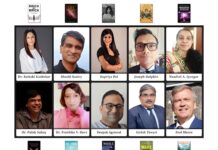 NEW DELHI: The thriving Urdu literary culture of 18th and 19th century in North Indian cities of Delhi and Lucknow that remained vigorous and resilient even at the face of glaring defeat in 1857 at the hands of ‘Company Bahadur’ is the subject of the book ‘The Sun That Rose from the Earth’ by noted Urdu poet and critic Shamsur Rahman Faruqi.
NEW DELHI: The thriving Urdu literary culture of 18th and 19th century in North Indian cities of Delhi and Lucknow that remained vigorous and resilient even at the face of glaring defeat in 1857 at the hands of ‘Company Bahadur’ is the subject of the book ‘The Sun That Rose from the Earth’ by noted Urdu poet and critic Shamsur Rahman Faruqi.
Only last month, his earlier book The Mirror of Beauty, also describing the high Urdu literary culture of 19th century, was long-listed for the prestigious USD 50,000 DSC Prize for South Asian Literature.
First published in the Urdu as ‘Savaar aur Doosre Afsaane’ in 2001 and translated in English by Faruqi himself, the book is a collection of five stories written between 1999-2012, all having a similar quest, “to rehabilitate in people’s mind ,” as Faruqi himself puts it, “the vigor and resilience of Urdu poetry amidst decaying imperial Mughal rule.”
Although fictional, the stories are replete with historical figures of Urdu literature like Mirza Ghalib, Mir Taqi Mir, Shaikh Mushafi, Budh Singh Qalandar, Kanji Mal Saba, and are set in the historical background of 18-19th century, some in the immediate aftermath of the calamity of 1857, thus placing the book in the category of historical fiction.
The stories are woven around the historical personage of these towering Urdu poets, and represent a quest for mastering the nuances and subtleties of their poetry. Faruqi, the noted Urdu literary critic is never missed in these stories, and often the protagonists of his stories not only chase, idealise and romanticize these great poets, but also discuss and critique them.
These Urdu poets, whose verses and shadows loom large in his stories, are drawn from a diverse Hindu-Muslim background to deconstruct the popular notion that equates Urdu with the language of Muslims. Budh Singh Qalandar, Kanji Mal Saba, Ikhlas were all Hindus.
“Urdu was not the property of Muslims alone,” says Faruqi, as he laments its association in the 20th century with the language of the Muslim Lashkar (army), or the language that caused partition.
In the first story, ‘Bright Star, Lone Splendor’, set in the immediate aftermath of 1857, Beni Madho Ruswa, the protagonist of the story who has been orphaned during the revolt, travels from his adopted home Cawnpore to Delhi to meet the greatest poet of his time, Mirza Asadullah Khan Ghalib, under the pretence of getting Ghalib’s diwan autographed by the poet himself.
Faruqi describes the labyrinth of Urdu poets in North Indian cities, the complex maze of poets in madrassas, Sufi shrines and imperial courts through which Beni Madho Ruswa learns the intricacies of Urdu poetry and grows with a secret desire of meeting the of Urdu poetry, Ghalib, some day in his life.
Though separated by age, religion, cities and ambitions, Beni Ruswa, the narrator of the story, and Ghalib get along easily, as both thrived on understanding and mastering Urdu poetry, and both were left desolated and devastated by the ghost of 1857, that haunts the story throughout.
How Delhi was crushed after the Company forces overtook Red-Fort is ably captured by Faruqi.
In a melancholy scene, Ghalib tells his visitor Beni Ruswa, “In the times of the Presence, Mirza Abu Zafar Sirajuddin Bahadur Shah, all these Delhi alleys, by-lanes and road were alive with bright lights . . . alive, dear sir, with myriads of lights and lanterns. And now, one’s own hand can’t find the other hand.”
Beni Ruswa sighs, and expresses the plight of Delhi by recalling a verse by Mir Taqi Mir:
“The city now is a maidaun, everywhere; Did such desolation-destruction prevail here ever before?”
Then, there is the story of aspiring poet and wealthy businessman Darbari Mal Vafa, who like the protagonist of his first story, is tracking down the obscure poet Shaikh Mushafi.
Darbari Mal Vafa travels to Lucknow, and learns of the life and work of the poet through the stories told by his widow.
There is the young Mir Taqi Mir, a rising star in the world of poetry, who meets the first great love of his life, Nurus Saadat, an exquisite beauty from Isfahan. Their first meeting is followed by a tumultuous love affair, accompanied by ravishing verse.
All these stories, are then about about the Urdu poetry and Urdu poets, whose heroes appear like a slightly disguised version of the author himself, walking down the lanes of pre-colonial Delhi and Lucknow, with his favorite poets in different historical settings.
As is the case with historical fiction writers, Faruqi is acutely aware of the historical image he wants to reproduce in his reader’s mind, and the long-held popular notions he wants to challenge through his fiction writing.
“Delhi by mid-nineteenth century was no longer the political capital of India and has been replaced by Calcutta as the power centre of the country,” says Faruqi, “but it was still the literary and cultural capital of north India. The sepoys of Awadh, who rebelled against the East India Company in 1857, Hindus and Muslims alike, declared the old Mughal capital of Delhi and not the new power centre Calcutta as the capital of free Hindoustan.”
As Delhi lost its political significance, says Faruqi, the Mughals revived many centuries-old courtly traditions to create a false aura of its authority.
Bahadur Shah Zafar, the last Mughal ruler, who was dethroned and deported to Rangoon after the 1857 revolt has been crushed, has himself ordered the restoration of many prominent buildings in Delhi.
Delhi was the city of Meer Taqi Meer. Bahadur Shah Zafar himself wrote highly lyrical poetry and his court was adorned by the likes of Ghalib, his great rival Zauq and Momin.
Together they were responsible for writing some of the greatest poetry in modern Indian history. This was also a period of great intellectual excitement, and the great works of mathematics and science from the west were translated into Urdu and Persian for the first time.
Delhi, says Faruqi, was not the decaying, degenerating city, waiting for its uninteresting end, as later colonial historians often described it, but was a robust, thriving centre of trade, art and culture, where great scholarly and literary minds gravitated and discussed and challenged each other’s work.
“This is the Delhi, and its high Urdu literary culture that I wanted to recapture, and recreate through my stories,” adds Faruqi, as he recalls another immortal couplet by Mir:
“It was not the lanes and streets of Delhi/ It was the pages of an album. /Each and every face that one saw, Was a painting.” -PTI







